
From manatees in Florida to a beach full of mussels in Portugal, take a look at the Highly Commended winners of Wildlife Photographer of the Year 2024
By
This year marks the sixtieth anniversary of Wildlife Photographer of the Year, the Natural History Museum’s annual competition and exhibition. Here, we showcase the Highly Commended winners of the 2024 Wildlife Photographer of the Year.
Selected from nearly 60,000 entries from 117 countries and territories, the overall winners of the sixtieth competition will be announced on 8 October. The exhibition of the 100 award-winning images will open at the Natural History Museum on Friday, 11 October.

Jason Gulley gazes through clear water at a manatee and a calf adrift among the eelgrass. Jason has photographed many manatee mother-and-calf pairs. The expression on this calf’s face and the bubbles trailing from its flippers, combined with the hopeful backstory, have made it one of Jason’s favourite images.
Here in the Crystal River, an algal bloom caused by agricultural runoff led to a decline in the eelgrass beds that the manatees eat. The local community acted, restoring the habitat and improving water quality, resulting in more manatees than ever being recorded in the winter of 2022/2023.
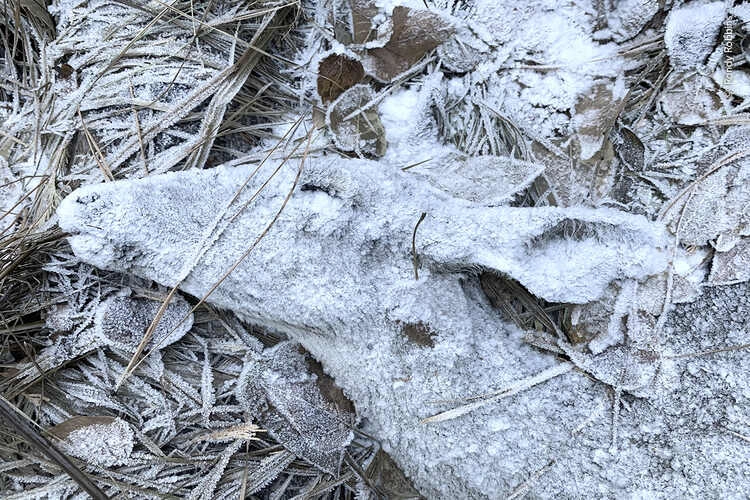
Randy Robbins is struck by the unusual beauty of the frosted form of this deer on the forest floor. On an early winter’s morning, Randy was checking the trail cameras near his home when he found the body of this deer. He photographed this poignant moment using his smartphone before the ice could melt.
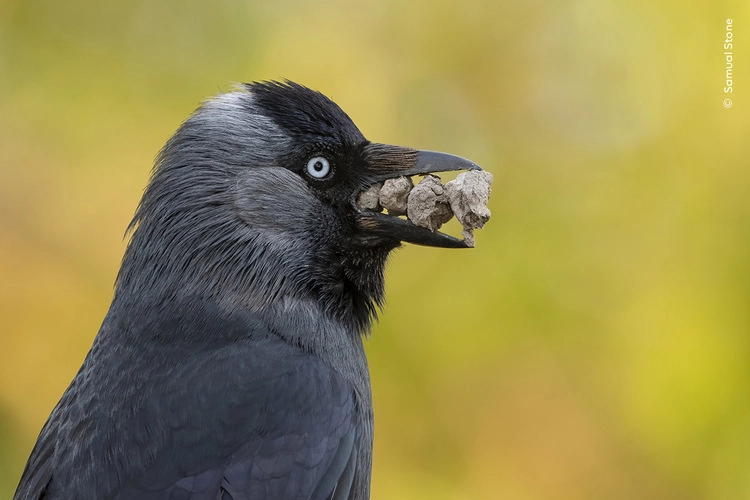
Samual Stone watches as a jackdaw brings stones to its nest. Samual had been keeping an eye on the hole in the trunk of a half-fallen willow tree in London’s Bushy Park – he’d seen a pair of jackdaws visiting with their beaks full of hair taken from the coats of local deer.
‘Jackdaws are highly intelligent and adaptable,’ says Samual. ‘They build new nests each year, from all sorts of materials: twigs, branches, feathers, wool, moss, mud and animal dung. This pair kept adding rocks to theirs.’
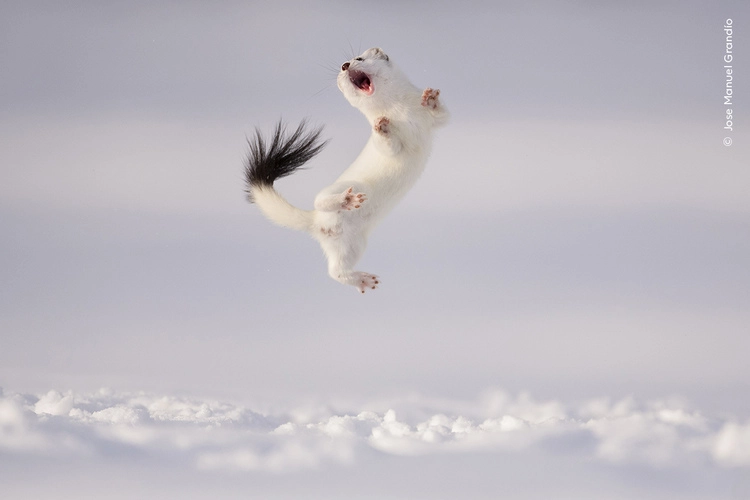
Jose Manuel Grandío braves below-zero temperatures to witness a stoat jumping high into the air above the snow.
Winter is Jose’s favourite season for photography. When he spotted this stoat jumping mid-air on the last day of his trip, he saw this performance as an ‘expression of exuberance’ as the small mammal hurled itself about in a fresh fall of snow. Scientists refer to this behaviour as dancing, although opinions are divided about what motivates it, from an attempt to confuse prey through to a parasitic infection. Stoats are usually active at night and prey on small mammals and birds.
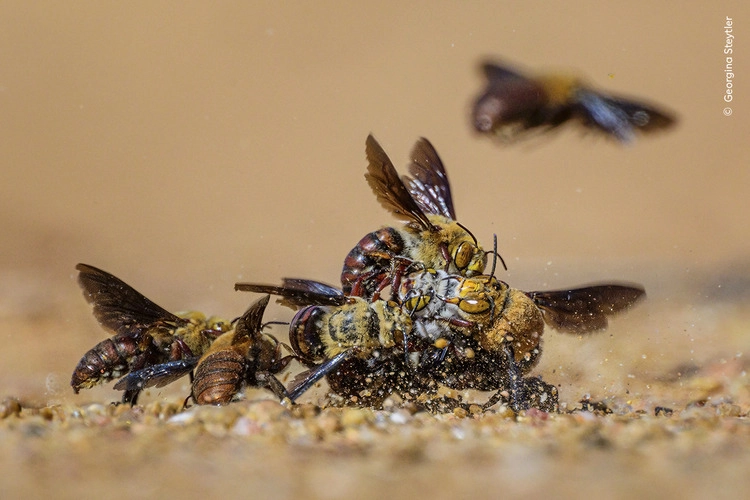
Georgina Steytler observes a ball of male Dawson’s burrowing bees vying for access to a female. Georgina has been studying these bees for a few years and knew she had to keep her distance. Lying on the hot, rocky, sun-baked ground with sand blowing in her face, her long lens enabled her to get the perfect image.
When female Dawson’s burrowing bees emerge in spring, they are surrounded by males competing to mate with them. After mating, the female bee will dig a new burrow filled with pollen and eggs, from which the hatched bees will emerge in spring.
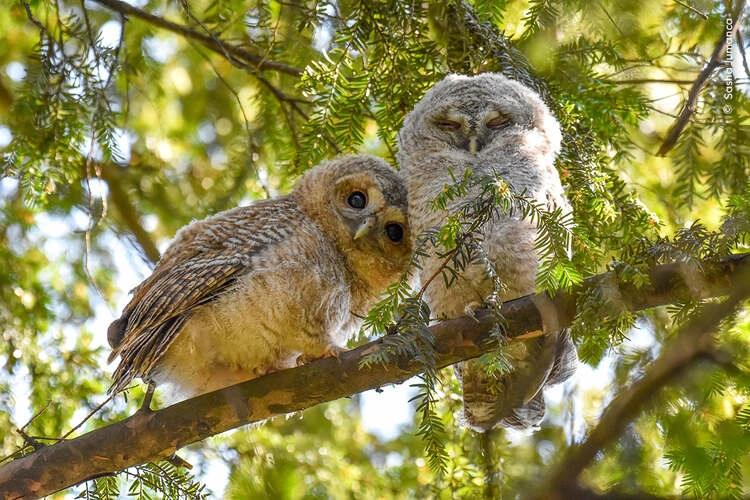
Sasha Jumanca finds two tawny owlets curiously watching people walking by, winning the Highly Commended prize in the 10-year-old and under category.
Sasha had been watching these tawny owlets for several days in a park near his home. He had seen tawny owls in the neighbourhood before but was surprised to discover these so close to the heart of the city. Owlets leave the nest before they can fly, in a phase known as ‘branching’. They will jump, flutter and climb around branches of nearby trees for several weeks while begging for food from their parents, before they eventually fledge and fly away.

Lam Soon Tak spots a vibrantly coloured David Bowie spider carrying an egg sac. Lam was exploring the highlands of Malaysia when he came across this spider. Perched on broken branches beside a river, the bright white disc of eggs in the spider’s jaws and its orange body stood out against the lush green moss.
Found in Malaysia, Singapore and the Indonesian island of Sumatra, this spider was named in 2008 by arachnologist and Bowie fan Dr Peter Jäger. He thought the striking markings up to the spider’s head region resembled the make-up worn by the singer during the 1970s.

Ian Ford documents the moment a jaguar delivers a fatal bite to a caiman in the Pantanal. A call over the radio alerted Ian that a jaguar had been spotted prowling the banks of a São Lourenço River tributary. Kneeling in the boat, he was perfectly placed when the cat delivered the skull-crushing bite to the unsuspecting yacare caiman.
The South American Pantanal wetland supports the highest density of jaguars anywhere in the world. With prey being so abundant, there is no need to compete for food, and the usually solitary big cats have been seen fishing, travelling and playing together.
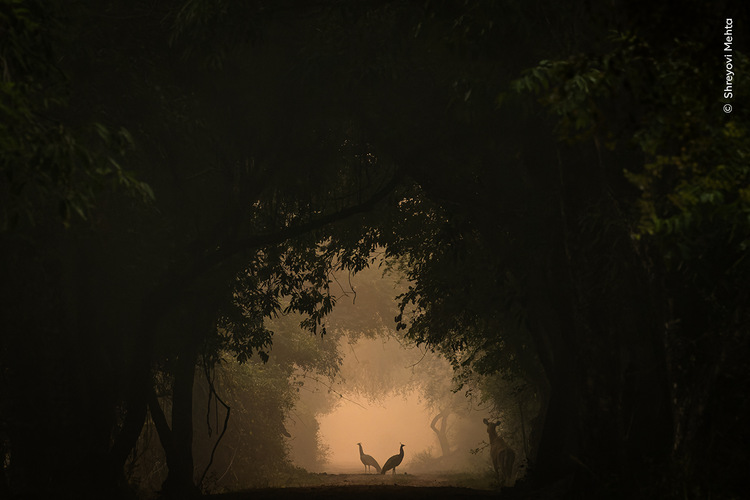
Shreyovi Mehta finds two Indian peafowls ‘looking perfect for a picture’ in her photograph, which won the runner-up prize in the 10-year-old and under category.
Shreyovi was walking in the forest with her parents when she spotted this scene. She ran back to her dad, who was carrying the cameras, then got down on the ground to take her photograph from a low angle. Renowned for its birdlife, Keoladeo attracts large numbers of water birds in winter. Peafowl are year-round residents that roost in large trees. They rest in the shade during the day and are more active in open areas at dawn and dusk.
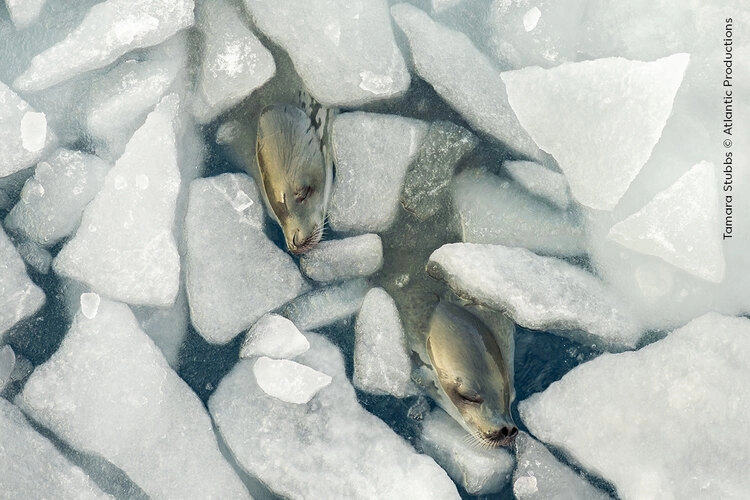
Tamara Stubbs spots these crabeater seals taking a nap among the sea ice. In a standout moment on her nine-week expedition in the Weddell Sea, Tamara noticed that seals had fallen asleep alongside the ship, with the tips of their nostrils at the water’s surface. These two had bobbed up so they could take a deeper breath.
There are around four million crabeater seals in the Antarctic. Although they are not considered endangered or under threat, the seals are protected by international conservation agreements. More research is needed to understand the impact of climate change and tourism on their populations.
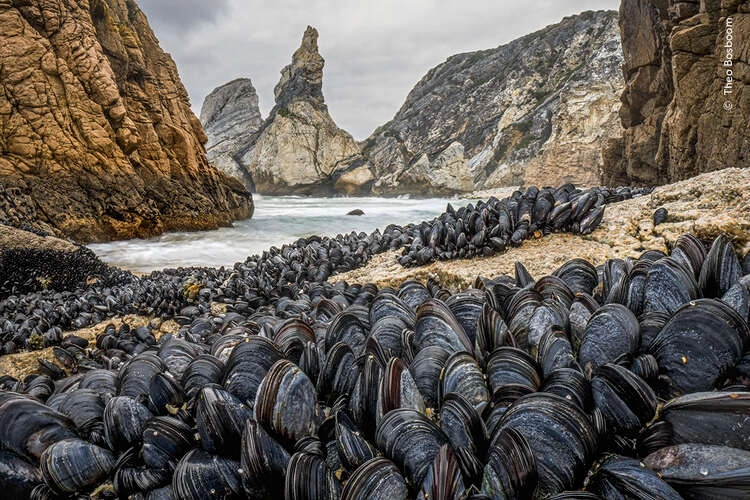
Theo Bosboom shows how mussels bind together to avoid being washed away from the shoreline. Theo likes to take images of species that aren’t usually considered beautiful or important, to highlight their unappreciated significance. He took this image from above with a probe lens – a long, thin, macro wide-angle lens.
Mussels play an important role in creating dynamic ecosystems for other marine invertebrates such as crustaceans, worms and even small fish. They improve the water quality by filter-feeding, extracting plankton as well as bacteria and toxins, which prevents them from building up to dangerous levels.
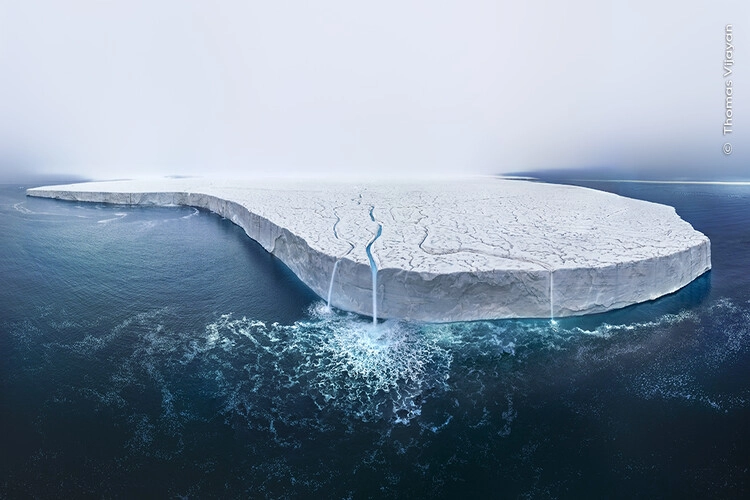
Thomas Vijayan utilises his drone to show the epic scale of the Bråsvellbreen glacier. Encapsulating the magnificence of the Austfonna ice cap required meticulous planning and favourable weather conditions. Thomas’s image, a stitched panorama of 26 individual frames, provides a spectacular summer view of meltwater plunging over the edge of the Bråsvellbreen glacier.
‘The Bråsvellbreen glacier is part of Austfonna, Europe’s third-largest ice cap,’ says Thomas. ‘This dome of ice is one of several that cover the land area of the Svalbard archipelago. Some scientific models suggest that Svalbard’s glaciers could disappear completely within 400 years due to climate change.’

‘William Fortescue uses a backdrop of storm clouds lit by the setting sun to show mating lions. It was the rainy season when William visited the Serengeti National Park. He watched the lions mate several times before the female broke it off. It wasn’t until William viewed an enlarged image that he noticed the saliva trails and the explosion of insects from the male’s mane.
Lions can mate throughout the year, but synchronising the births of cubs increases the reproductive success of a pride. Female pride members display cooperative behaviours, including raising cubs together to ensure their survival into adulthood.
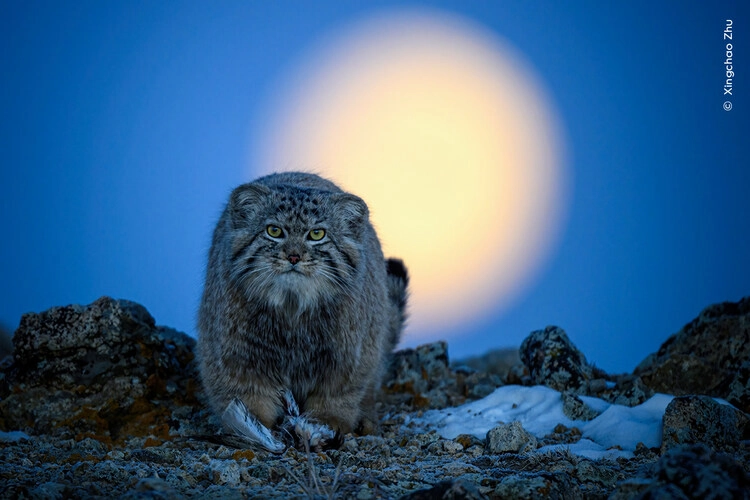
Xingchao Zhu comes face to face with a Pallas’s cat as the moon sets. Xingchao tracked a group of Pallas’s cats on the freezing plateau of Inner Mongolia for several days during the Chinese New Year in February 2023. Shortly before dawn, Xingchao managed to make eye contact with this cat, just as it had caught a small bird.
The thick winter coats of Pallas’s cats help them survive at altitudes up to 5,000 metres (16,400 feet). They avoid larger predators by stealth, and it’s thought that their low, rounded ears allow them to peer over obstacles while remaining hidden.
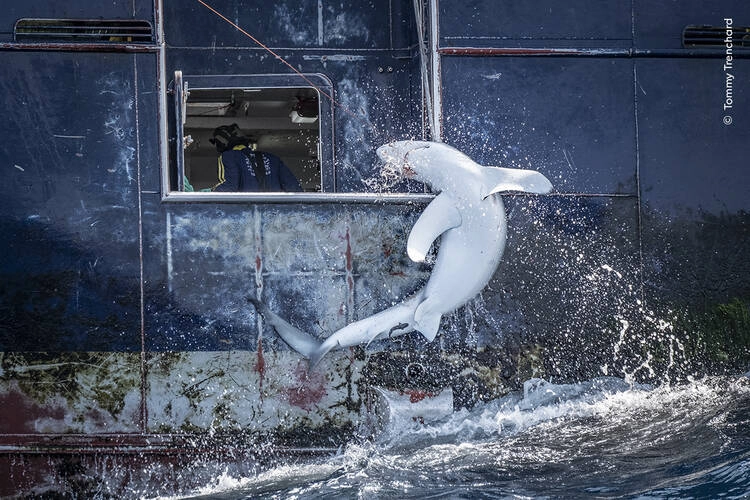
Tommy Trenchard documents the bycatch of a requiem shark, its body arched in a final act of resistance. Tommy was travelling on the Greenpeace ship Arctic Sunrise. The ship’s research expedition aimed to document the bycatch or accidental capture of sharks by fishing boats targeting tuna and swordfish, and to highlight the lack of effective regulation of industrial-scale fishing in international waters.
Approximately 80 million sharks are taken from the world’s oceans every year. Because of fishing, numbers of sharks worldwide have dropped since 1970. Three-quarters of all shark species are now at risk of extinction.




